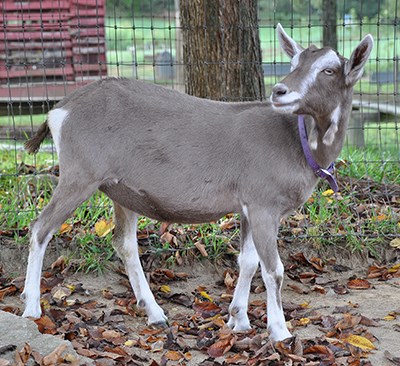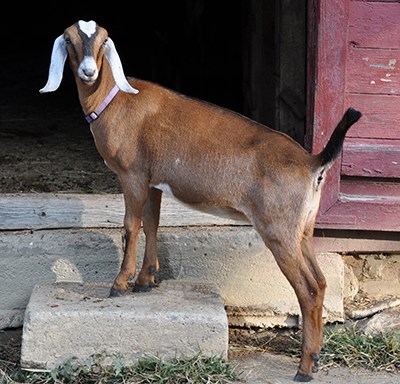
Photo by June Glenn, Jr We know the spring births of goat kids are popular, however the herd this year is very young, mostly yearlings (born last year) to three years old. We are also at the maximum herd size of 15-17 goats. For these reasons we decided to not breed any goats for the 2022-2023 season. Learn more here. Mrs. Sandburg's Connemara FarmsInternationally renowned as a goat breeder, Lilian “Paula” Sandburg was one of the outstanding pioneers of the American dairy goat industry. While her husband dedicated himself to a long literary career, Mrs. Sandburg enthusiastically pursued an ambition to raise and breed champion dairy goats. Her pursuit brought the family to Flat Rock, North Carolina in 1945, where she and their youngest daughter Helga established the Connemara Farms Goat Dairy. The family lived and worked in this tranquil, pastoral setting for 22 years, until Carl Sandburg’s death in 1967.The production and sale of milk were secondary to Mrs. Sandburg, whose fundamental goal in raising dairy goats was the development of champion milk-producing stock. Through her scientific breeding methods she produced many champion animals and helped modernize the dairy goat industry, increasing its acceptance as a legitimate form of farming. The industry recognized her leadership in 1961: To Mrs. Sandburg, in grateful recognition of your many years of service and devotion to the dairy goat industry, which have resulted not only in better dairy goats with higher production, but also in the development of the finest possible public relations program within the industry... We honor you, Mrs. Sandburg, as one of our outstanding breeders, whose leadership in the industry is unsurpassed. 
Connemara Farms TodayVisitors to Connemara Farms can see dairy goats that are descended from Mrs. Sandburg's famous herd. She raised three breeds of dairy goats; Saanen, Toggenburg, and Nubian. Each breed can be seen in the herd today. Toggenburgs: Toggenburgs were the first purebred goats in the Chikaming herd. This breed originated in the Toggenburg Valley of Switzerland. Toggenburgs are a brown color with distinctive white stripes on their face and legs. They were the first purebred dairy goats brought to America, with the first ones arriving as early as 1893.Toggenburgs were the most famous Chikaming breed. Mrs. Sandburg admired Toggenburgs the most as they were the breed that achieved the highest production records in her herd. Chikaming Toggenburgs were outstanding in both production and in the show ring. 

CheesemakingThe Sandburg family enjoyed many of the products made from goat milk. Here are three of Mrs. Sandburg’s cheese recipes, try them at home:Semi-Soft Brie or Chevre Equipment:
Ingredients:
Procedure:
Dissolve 1 rennet tablet (or ½ tsp. liquid rennet) in 1 tablespoon water. Heat milk to 80°F in pot, add dissolved rennet, cover and set aside for 4-8 hours to curdle. Use slotted spoon to fill cheese molds** with curds and whey – fill to brim. Add celery, anise, or caraway seeds now if seasoning is desired. Put lids on molds and place on a cake or cooling rack to drain for 3 days. Invert or turn mold over every 12 hours or less. Remove cheese from mold, salt on all sides with regular table salt to prevent molding (scrape off any mold that might occur). Wrap cheese loosely in cheesecloth, place on cooling rack to age in a cool place 60°F. Age cheese for 7-28 days and enjoy! *When using pasteurized milk (vs. raw) with above recipes, add ½ cup buttermilk per gallon milk.
**Cheese molds can be made from coffee or juice cans, etc. with holes punched on all sides, bottoms, and lids from inside out using a nail or ice pick. Queso Blanco Ingredients:
Procedure:
Heat milk directly on burner stirring constantly to 185-190°F. While stirring slowly add vinegar. Turn off heat. Line colander with muslin. Pour curdled milk into cloth. Drain for a few minutes then tie up cloth to drain completely. (Takes several hours.) Remove, place in bowl, and add salt. Refrigerate.
|

